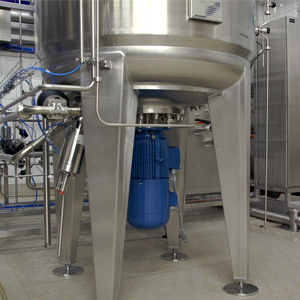FRIBORATOR TRG AERATION TURBINES
Energy-efficient and low-maintenance aeration turbines for installation in large reactors

PRODUCT DESCRIPTION
The most powerful units of the FRINGS aeration turbines are found within the FRIBORATOR TRG product line.
Here we offer the mixing and gassing units with a drive power of up to 450 kW for large reactors with several 100,000 liters for the production of “commodities”.
In many large-volume production processes in chemistry or aerobic processes in biotechnology, the economic efficiency analysis shows the energy consumption of the reactor agitators as a significant matter of expense in addition to the raw material costs.
And this is exactly where we start with our TRG technology
Excellent gas transfer rates at comparatively low drive powers for the TRG aeration turbine and the associated compressor unit are the outstanding features of TRG technology. No dynamic agitator or static gas injection system known to us has a similar efficiency (kg gas/kWh or kmol gas/kWh) with comparable less installation effort.
DRIVE TYPES
FRINGS TRG systems are available in sizes covering the range from 1,000 – 12,000 m3/h and 20 – 450 kW. The TRG systems working with pre-pressure have a speed range of 250 – 800 rpm depending on the size.
The shaft sealing is done with single or double acting mechanical seals.
They can be supplied with different drive forms according to requirements and power class:
- mit Stirnradgetriebemotor
- mit Kegelradgetriebeantrieb
- mit wassergekühlten Mehrmotorantrieben
- optional mit Frequenzumformer
NOTE:
The drive power for the TRG aeration units in aerobic fermentations is usually only between 1 and 2 kW/m3, based on the working volume of the industrial bioreactor. With these capacities oxygen transfer rates of 4 – 8 kgO2/m3/h can be achieved. However, our portfolio also includes extensive aeration systems and systems with significantly higher specific power input.
DIFFERENT DESIGN STANDARDS OF FRINGS AERATION TURBINES:
- FRIBORATOR P: for sterile technical processes in biotechnology
- FRIBORATOR B: for hygienic processes in the brewery and beverage industries
- FRIBORATOR G: with equipment and documentation according to GMP pharmaceutical standards
- FRIBORATOR C: without sterile or hygienic design according to chemical standard
- FRIBORATOR TRG: for large reactors (bio commodities, baker’s yeast, …) with additional blower
WHAT ARE FRINGS AERATION TURBINES AND HOW DO THEY WORK?
FRINGS aeration turbines and submerged aerators are high-performance systems for the optimal introduction of gases in chemical reactors, bioreactors and other gas/liquid apparatus.
In particular, these aeration systems are designed for chemical gas/liquid reactions in the low-viscosity range and for oxygen supply of bacteria and yeast cultures.
High performance for an optimized reaction speed
The mass transfer of gas into the liquid is often the rate-limiting step in gas-liquid reactions.
With FRINGS aeration turbines it is possible to increase the speed of this mass transfer compared to other aeration systems.
In chemical reactions this means an increase in the reaction speed and in microbial processes an increased growth and product formation rate.
Minimum installation effort and optimized energy consumption
Unsere Begasungsturbinen und Tauchbelüfter bestechen durch die Eigenschaft, selbsttätig Gas anzusaugen In vielen Anwendungsfällen kann daher ein Gaskompressor/-gebläse entfallen und eine Anlagengestaltung ist mit minimalem Installationsaufwand möglich. Selbst wenn doch ein Vordruck erzeugendes Gebläse zusätzlich installiert werden muss, ergeben sich bei geeigneter Regelung außerordentlich effiziente Systeme mit sehr geringem, spezifischem Energieverbrauch.
Arbeitsweise des FRINGS Begasungssystems
In FRINGS gassing systems, the star-shaped rotor located at the bottom of the tank to be gassed sucks in liquid axially and accelerates it radially and tangentially at the working surfaces.
A vacuum area is created on the rear side of the working surfaces, which are connected to the gas line, during rotation. Due to the pressure difference compared to the gas pipe, gas flows out into the working area of the rotor and is intensively mixed with the liquid.
The liquid/gas mixture is conveyed into the channels of the stator. At the channel outlets, whose length and geometry depends on the diameter of the tank and the rheology of the medium, the mixture flows out turbulently.
 CONTACT PERSON
Biotech-Team
CONTACT PERSON
Biotech-Team






